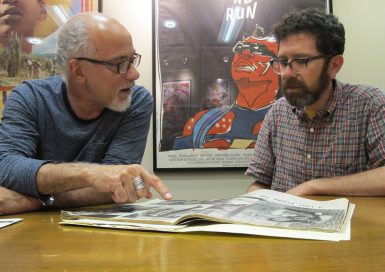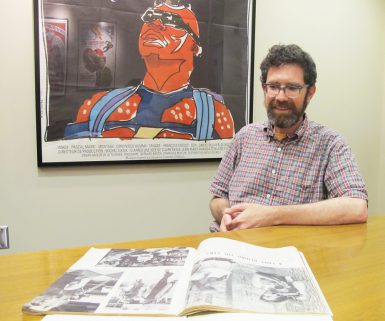Black Film Center/Archive receives grants for preservation project, symposium

Indiana University’s Black Film Center/Archive has been awarded two grants that will support a two-day symposium in the fall and a new film preservation project.
The first of the two grants, awarded by IU’s College Arts and Humanities Institute, will help fund the symposium From Cinematic Past to Fast Forward Present: D.W. Griffith’s The Birth of a Nation, set for Nov. 12-13 in conjunction with the centennial of the film.
Attendees of the event will discuss the relevance of the film not only cinematically, but also politically and culturally. The Birth of a Nation is a 1915 silent film that tells the story of the reconstruction of the American South after the Civil War. The film, which was the first 12-reel film in the country, was a commercial success but generated public outcry for its grotesque caricatures of African Americans and its heroic portrayal of the Ku Klux Klan, including the KKK’s lynching of a black man.
Professor Michael Martin, director of center, said he wants to make clear the symposium isn’t a celebration of the film. While the film has been referred to as one of the most controversial in history, Martin said the issues that arise through the film are those still facing the country today.
“It has stock in the moment — that some would argue is a post-racial moment, though that is hard to imagine with all the things going on in Ferguson and this most recent massacre that occurred in Charleston,” Martin said of the film. “It’s a window into the past that speaks to the present in important ways.”
The symposium will feature a screening of The Birth of a Nation at IU Cinema in a 35mm print preserved by the Museum of Modern Art with support from the Lillian Gish Trust for Film Preservation. Rodney Sauer, a silent-film pianist from the Mont Alto Motion Picture Orchestra, will provide live accompaniment.
In addition to the screening, attendees will hear keynote addresses from Melvyn Stokes of the University College London, who organized a symposium about the film at that school in June; and Linda Williams, film and media professor emerita at University of California-Berkeley. They’ll also listen to scholars on three panels discussing the film’s connection to current day issues in race relations and media representations and will participate in a roundtable discussion.
Martin said IU is an ideal place to view the film in its original format as well as to discuss the film’s relevance today.
“We are going through a film renaissance on this campus,” he said. “We have an extraordinary archive of films, which are arguably unrivaled. Second, we have the facility to show the film in its complete format.”
Earlier this year, the symposium also received grant funding through an IU Ostrom Grant at the College of Arts and Sciences and through the the New Frontiers in the Arts and Humanities program at the Office of Vice President for Research. The Media School is co-sponsoring the symposium.

The second grant was awarded to the center by the National Film Preservation Foundation to fund the preservation of director Jessie Maple’s 1989 independent film Twice as Nice. The foundation is the nonprofit organization created by the U.S. Congress to help save America’s film heritage.
Twice as Nice follows the diverging paths of twin sisters Caren and Camilla Parker, both basketball stars on a powerhouse college women’s team, who struggle to balance their studies, family life, friendships, romance and basketball. The Parker sisters are played by real-life twins and basketball legends Pamela and Paula McGee, who, along with Cynthia Cooper (Damita Jean Johnson in Twice as Nice), led the University of Southern California’s women’s basketball team to back-to-back NCAA championships in 1983 and 1984. Both Pamela McGee and Cynthia Cooper won gold medals in the Olympics before finding further professional successes in the WNBA.
Maple deposited her collection at the center in 2005. It included assorted outtakes and other incomplete elements of Twice as Nice, but did not contain enough material to conduct a complete restoration. Brian Graney, the center’s senior archivist and head of public and technology services, said he had been trying to round out the Maple collection with a completed version of Twice is Nice.
This became more of a possibility when curator Ed Carter at the Academy Film Archive discovered the original picture and track elements in storage at DuArt Film Lab in New York. The company, which provided film duplication and storage services for independent filmmakers, is closing its film division. Carter and other preservationists are working with DuArt staff to find homes for films that have been left, sometimes for decades, at the lab.
Martin said Carter identified the center as a home for Twice as Nice not only because it already possesses Maple’s collection, but also because of the relationships the center has cultivated with other organizations dedicated to film preservation.
“It’s not just the fact that there’s a Black Film Center/Archive at IU,” he said. “It’s also the kinds of relationships that Brian and others have developed over time with Lincoln Center, MoMA (Museum of Modern Art), the Academy Film Archive and other institutions.”

Graney said another contributing factor to the center’s receipt of the preservation grant was the public rediscovery of Maple’s work. This year, the Museum of Modern Art and Lincoln Center screened the center’s 2008 restoration of Maple’s first feature film, Will, as part of a series, Tell it Like It Is: Black Independents in New York, 1968-1986, which included an evening dedicated to Maple.
The preservation of Twice as Nice should take close to a year, Graney said. He already has completed inspection of the elements of the film to assess their condition and completeness. Next, he will send the elements to the film laboratory Colorlab in Rockville, Maryland, where he has reviewed restoration recommendations with lab technicians.
Graney said Maple has expressed interest in participating directly in preservation efforts at the lab, and once she is confident the project reflects her original vision, the center will produce a 16mm preservation element, a 16mm release print and a digital master of the film.
Both Martin and Graney said the center’s preservation of Twice as Nice and the National Film Preservation Foundation’s grant come from a shared passion for preserving films in their original format.
“This project is preservation of film on film,” said Graney. “This is a work that was created on 16mm film, and this project makes possible its continued exhibition in the original format.”
The Black Film Center/Archive is located in the IU Wells Library 044.

